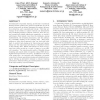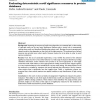10 search results - page 2 / 2 » Mining Sequential Patterns with Negative Conclusions |
BMCBI
2007
13 years 5 months ago
2007
Background: Identification of protein interacting sites is an important task in computational molecular biology. As more and more protein sequences are deposited without available...
KDD
2005
ACM
14 years 5 months ago
2005
ACM
Discriminative sequential learning models like Conditional Random Fields (CRFs) have achieved significant success in several areas such as natural language processing, information...
BMCBI
2006
13 years 5 months ago
2006
Background: The extended use of microarray technologies has enabled the generation and accumulation of gene expression datasets that contain expression levels of thousands of gene...
BMCBI
2005
13 years 5 months ago
2005
Background: Type 1 diabetes mellitus (T1DM) is a autoimmune disease caused by a long-term negative balance between immune-mediated beta-cell damage and beta-cell repair/regenerati...
ALMOB
2007
13 years 5 months ago
2007
Background: Assessing the outcome of motif mining algorithms is an essential task, as the number of reported motifs can be very large. Significance measures play a central role in...


